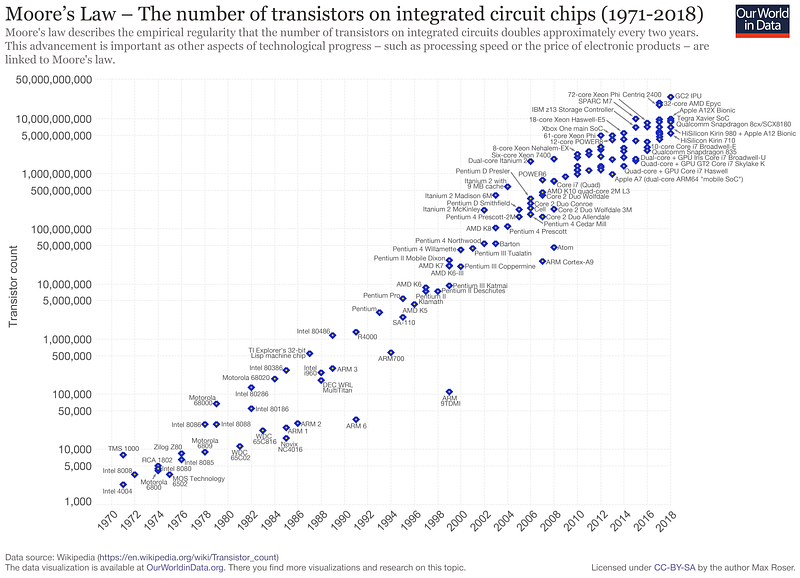The Ever-Evolving Narrative of Moore's Law: Alive or Dead?
Written on
Introduction to Moore's Law Debate
During the Semicon West 2019 conference, a panel of industry professionals initiated a discussion on the current status of Moore’s Law. This influential prediction made by Gordon Moore stated that the number of components on integrated circuits would consistently double over a set timeframe—initially every year, later extended to every two years. Over the past ten years, the discourse regarding the long-term viability of Moore’s Law has intensified, with some arguing it has either reached its limits or evolved into new forms of scaling.
As expected, opinions vary widely on this subject. In previous discussions, I have pointed out that while the original wording of Moore's 1965 forecast remains unchanged, our interpretations of it have significantly evolved. Initially focused on transistor density, Moore’s Law has expanded to encompass performance predictions as well. The concept of node scaling has also transformed; it has been two decades since node names directly referred to specific feature sizes. When companies like TSMC, Samsung, or Intel announce a new node, they are referring to a combination of innovative techniques, potentially smaller feature sizes, material advancements, and manufacturing enhancements that collectively validate the claim of a new transistor manufacturing method.

According to Aart de Geus, co-CEO of Synopsys, the essence of Moore’s Law is akin to an exponential function influenced by economic feedback loops that have catalyzed a technological revolution. He asserts that the concept remains very much alive, as we are poised for another decade or two of extraordinary opportunities that will continuously drive technological advancements. While the trajectory may not mirror Moore's original curve, that distinction is irrelevant.
Conversely, Victor Peng, CEO of Xilinx, distinguishes between the traditional scaling of Moore's Law—which historically provided enhancements in performance, power efficiency, and area—and the current reality where companies must concentrate on one or two of these aspects. He suggests that in this regard, Moore’s Law is losing its efficacy.
AMD's CEO Lisa Su, who recently unveiled groundbreaking CPUs, believes that Moore’s Law is not dead but is indeed slowing down. She emphasizes the necessity for companies to integrate more advanced technologies beyond conventional node scaling to thrive. Various industry figures have shared insights on this matter, highlighting that interpretations of Moore’s Law's evolution largely depend on which alternative technologies sectors are leveraging to further silicon advancements, such as 3D NAND stacking, advanced packaging, or innovative material technologies that enhance performance.
The ongoing debate about the status of Moore’s Law serves as a revealing indicator of its significance. For seasoned computer enthusiasts, it’s hard to forget a time when even pondering the question "Is Moore's Law dead?" would elicit puzzled looks. The interpretation of Moore’s Law, whether as a measure of transistor density or as a broader concept including performance and power consumption, has been a source of contention for decades. Despite its evolving definitions, the existence and functionality of Moore's Law have remained unquestioned. Today, however, there is a palpable effort to find alternative definitions that allow for the continued relevance of Moore's Law, mainly because its classic definition no longer holds true.
Yet, reaching a point where the original definition has become obsolete signifies a pivotal transition. While it may be helpful to retain the idea of Moore’s Law to describe equivalent advancements, doing so alters the foundational understanding of what it was originally intended to represent. Ultimately, Gordon Moore’s groundbreaking paper presents a philosophical dilemma akin to the ship of Theseus: at what moment does Moore’s Law cease to be itself? When does the engineering reality it once described become so detached from what the law purported to signify that they no longer bear any connection?
It would be quite amusing if, five centuries from now, AI-driven executives of major conglomerates were still discussing Moore's Law while referencing advances in technology that Gordon Moore could never have envisioned, such as quantum peanut butter computing singularities. Given the nature of marketing, I wouldn’t wager against it.
Chapter 2: Exploring Moore's Law's Future
This video titled "Is Moore's Law Finally Dead?" delves into the ongoing debates surrounding the relevance of Moore’s Law in today’s technological landscape. It examines various perspectives and provides insights from leading experts in the field.
In the video "Is Moore's Law Dead? in 2022," various industry leaders discuss the implications of Moore's Law and its current status, highlighting the challenges and innovations that lie ahead.